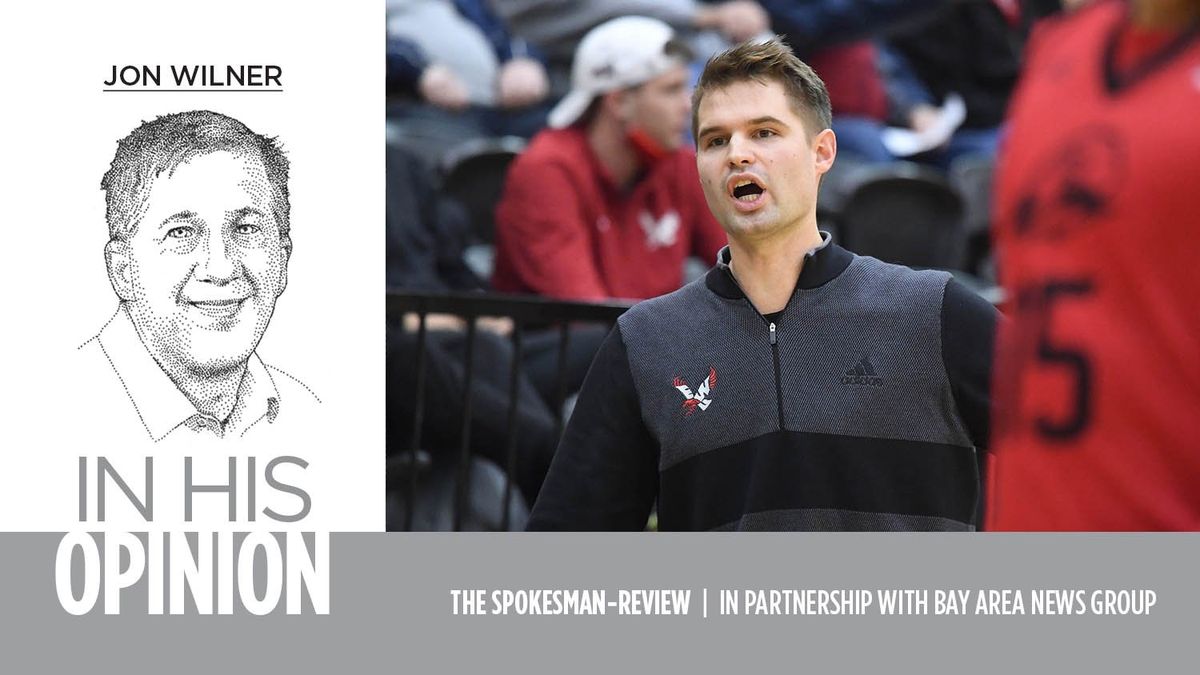WSU’s hiring of David Riley: The best move the Cougars could have made under the circumstances

How should we assess Washington State’s decision to hire David Riley? The easy answer is also the most reasonable answer: with blinders on.
Forget that Riley, who is arriving from Eastern Washington, was reportedly the second choice behind Montana State coach Matt Logie.
Forget that Riley is just 35 years old.
Forget that he has never coached at the power conference level.
Those issues are largely irrelevant, because the Cougars must be graded on a curve. The circumstances are so unusual, what with the Pac-12’s collapse and WSU’s uncertain future, that standard rules do not apply.
And in their effort to replace Kyle Smith, who left Pullman for Stanford last week, the Cougars did as well as they could have hoped.
Put another way: Had we told you ahead of time that WSU would end up with the two-time Big Sky Coach of the Year (2023-24), with a coach who knows every cranny of the Pacific Northwest and has beaten teams with greater resources and richer traditions – that resolution probably would have been well received.
Across the state, Washington earned all sorts of kudos for hiring Danny Sprinkle last week.
Well, Riley is Sprinkle Light. He’s 12 years younger and slightly less experienced as a head coach but on a comparable track.
Sprinkle’s head coaching resume consists of four seasons at Montana State, where he won 68% of his Big Sky games, and one terrific season at Utah State.
Riley’s resume: Three years at Eastern Washington, where he won 75% of his Big Sky games.
They even share Pacific Northwest college football bloodlines. Sprinkle’s father, Bill, played at Washington; Riley’s uncle, Mike, coached at Oregon State.
We aren’t suggesting that Riley and Sprinkle are equals as coaches but, rather, that they are equal as coaching hires given the enormous disparity in resources and platforms between the two schools.
Is Riley qualified to lead Washington State, which will compete in the West Coast Conference for two seasons? Absolutely.
Is he less likely to succeed than Montana State’s Logie, who reportedly was WSU’s first choice but declined the position? Not necessarily.
Logie has a string of winning seasons on his resume, all of them at the Division II (Point Loma of California) and Division III (Whitworth) levels. But his Division I experience consists of a single year at Montana State, where he went 9-9 in the Big Sky and split the series with Riley and Eastern Washington.
That’s all a way of saying that none of the available options was risk-free, but it’s unclear that Riley presents a greater risk than anyone else WSU might have considered.
Because of their uncertain future beyond the two-year affiliate membership in the WCC and the need to watch their money, the Cougars had limited options.
To the extent that we can draw any conclusions before Riley coaches his first season, WSU did as well as possible.
And don’t forget, Riley’s coaching acumen is merely one of two pillars that will support the program’s success during this transition phase. The other is the cash available to keep current players and attract new ones through the Cougars’ name, image and likeness (NIL) efforts.
If WSU musters a decent NIL game, Riley has a fighting chance to craft a roster capable of competing for the top tier of the WCC, alongside Gonzaga and Saint Mary’s.
That would have been the case with Logie at the helm, as well. And it’s the case with Sprinkle in Seattle, too, just at a different level.
Without strong NIL funding, every program will struggle for traction in the current environment.
Then again, we aren’t sure results in the WCC (good, bad or mediocre) will matter much to WSU’s athletic future.
Instead, the endgame depends on using the resources secured in the legal settlement with the Pac-12’s departing schools to:
• Reconstruct the conference in time for the 2026-27 college sports season via a reverse merger with the Mountain West; or
• Remain relevant in football long enough for additional realignment to create a new landscape that places WSU and Oregon State on the same competitive tier as the outgoing Pac-12 schools.
To that end, the Cougars have a more significant decision to make in the coming weeks: how to replace athletic director Pat Chun, who recently accepted the same position at Washington.
The wrong athletic director could adversely impact WSU’s strategy in the Pac-12 reconstruction and college football realignment games.
And that would have immense consequences for Riley and his program.